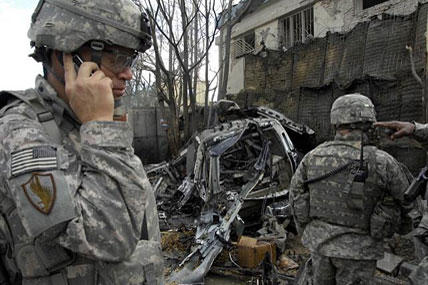The Army has reversed course and approved the 3rd Infantry Division’s urgent request for new computer software to analyze intelligence data -- the latest twist to a long-running dispute over the Palantir system that field commanders in Afghanistan have praised as “a lifesaver.”
“They are in theater (in Afghanistan) and using it right now,” an Army official said Thursday of the 3rd ID, which deployed to Afghanistan in August. The official, who spoke on background, added that the Army also was “working with Palantir to try to merge some of their capabilities into our system.”
The Palantir software system has been designed to mine vast government data bases to find links and connections in the intelligence to help troops quickly establish patterns of behavior among insurgents and to pinpoint the possible locations of improvised explosive devices, or roadside bombs, and the bomb makers.
The Army had blocked the division’s request to train with Palantir stateside at Fort Stewart, Ga., on procedural grounds.
In a series of memos between Army acquisition chiefs and the 3rd ID, first reported by Defense News, the Army said that it could not approve Palantir’s offer to provide servers on an “at risk” contract, meaning the firm would not be paid unless the 3rd ID was satisfied.
Heidi Shyu, the Army’s acting assistant secretary for Acquisition, wrote that the initial cost-free arrangement with Palantir violated Army contract procedures and “these circumstances warrant immediate corrective action by the Army to ensure that we comply with fundamental rules relating to how the government obtains goods and services from industry.”
But Shyu’s memo left open the possibility that Palantir would be available on deployment once procedures were followed, and the 3rd ID apparently complied, although the specifics of the contract could not be immediately determined.
Spokesmen for Palantir Technologies did not respond to requests for comment, but the Army’s action appeared to be a victory for the small Silicon Valley firm. Palantir has lobbied to supplement the Army’s existing intelligence analysis system, called Distributed Common Ground System-Army, which was developed by defense industry giants Raytheon and Lockheed.
The Army official, who spoke on background, said the Army’s current DCGS system for intelligence analysis was more of a “system of systems” for coping with vast amounts of data, while Palantir “provides one capability” for looking at data that has appeal for some users.
The dispute over Palantir has become a main issue for Rep. Duncan Hunter, R-Calif., and several members of the House Armed Services Committee who have argued that Palantir case illustrates the failure of the military’s acquisition system to meet the changing demands of troops.
“There have been plenty of opportunities to address the bigger issue, which is why ground combat units are struggling to acquire the technology they want and need,” Hunter said in a statement.
“It was eight months ago when the 82nd Airborne’s request was approved (for Palantir), only after repeated requests and denials, and in the time since, we’ve learned about more ground combat units that have been obstructed by Army bureaucrats,” Hunter said.
In the case of the 3rd ID, the division in Afghanistan was using Palantir servers in Regional Command-South in Kandahar under an existing license for the site, a spokesman for Hunter said.
Palantir has been used and praised by the Marines, the 82nd Airborne Division, Special Operations Command, the FBI and CIA.
In a February letter to the Pentagon’s Combating Terrorism Technical Support Office, Marine Maj. Gen. John Toolan, former commander of Regional Command-Southwest in Afghanistan’s Helmand province, wrote of his troops’ success in using Palantir.
“I am pleased to report that Palantir has performed outstandingly,” Toolan wrote. “Intelligence analysts find it straightforward and intuitive. Palantir reduced the time required for countless analytical functions and streamlined other, once cumbersome, processes.”






























